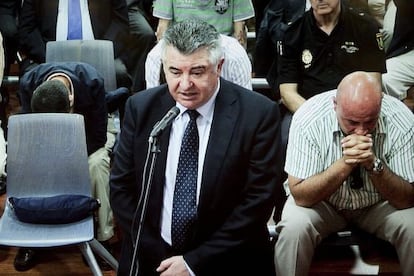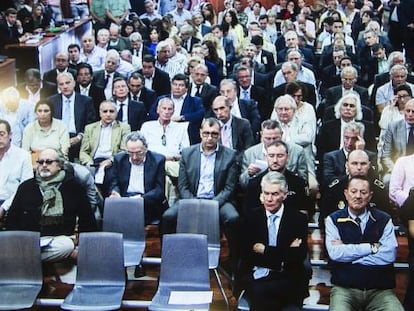The fake Miró, the chopper and the horse ranch: How much is Roca worth?
Details of Marbella corruption kingpin’s vast empire emerge after Malaya ruling

The centerpiece of corruption in Marbella reportedly hung in the bathroom of Juan Antonio Roca, the former urban planning chief in the Andalusian resort town who was sentenced last week to 11 years in prison and fined 240 million euros: a Miró. But it was an optical illusion. “Look into my eyes,” Roca said to his lawyer when asked about the painting. “Do you think I’m that stupid?” The “Miró” turned out to be a 200-euro print.
Roca’s fortune, amassed during the real estate boom and Marbella’s zenith as a hotbed of corruption under the town’s gaudily flamboyant late mayor Jesús Gil, is estimated at 90 million euros in properties, classic cars, artworks and aircraft. Seven-and-a-half years after the police launched its investigation, the tax authorities have recouped just 10 million from an estate so difficult to quantify that Roca himself was required to clarify certain aspects. His wealth was channeled through 71 separate companies and included 130 rural homes, dozens of urban properties and several mansions. He also acquired a thoroughbred horse-breeding ranch and another to rear fighting bulls, as well as lemon orchards with 35,000 trees.
On top of what could be considered orthodox purchases were a helicopter and an airplane for his Marbella Airways venture, hundreds of works of art and a taxidermy collection that rapidly lost its value because, according to the maker’s invoices, the bullet holes were left uncovered. His vintage car collection, including a 300,000-euro Mercedes, was bought by a Navarre businessman; 30 antique carriages were valued at 3.7 million euros; the helicopter went for 900,000 and the plane, a Cessna Citation II 550, is now used by the police. The court report states that Roca made 30 million euros in clean money in a two-and-a-half-year period.
Some of Roca’s acquisitions carry a whiff of pillage — 400 artworks stored in a Córdoba warehouse required the appraisal of experts from the regional government who determined there were three major pieces: a Van Dyck, a Sorolla and a Manolo Valdés sculpture. But the process was shrouded in mystery. Many of the works were destined for bishops’ palaces and regional museums but never reached a concrete destination.
The court report states that Roca made 30 million euros in clean money in a two-and-a-half-year period
“I don’t remember anything about it. I can’t answer your questions,” art expert Eugenio Carmona told this newspaper. The majority were given to the Ansorena gallery in Madrid: 167 pieces for auction and 197 for its vaults. A spokesman for the gallery declined to elaborate.
Roca also had cash, but not in amounts that would correlate to such a vast hoard. His accounts in Spain were few and with modest balances. Others in tax havens (he held one in the Isle of Man) turned out to be empty when investigators inquired.
Roca was not an ostentatious man. His public image was discreet and to a point even austere. He is an educated man, polite to employees, and schooled in the background of the raucous Gil era. He was also able to remember everybody’s price. “I’m sorry, my dear, but I gave you money on behalf of Jesús Gil,” he responded to Marisol Yagüe during the Malaya case, the largest anti-corruption investigation ever brought in Spain; the number of Marbella officials arrested led to a caretaker government being installed in the town. Yagüe, a former mayor, was sentenced to six years at its conclusion. In the courtroom after the gavel had fallen, the majority of the 95 suspects went to shake Roca’s hand, a signal of the power he once wielded.
Tu suscripción se está usando en otro dispositivo
¿Quieres añadir otro usuario a tu suscripción?
Si continúas leyendo en este dispositivo, no se podrá leer en el otro.
FlechaTu suscripción se está usando en otro dispositivo y solo puedes acceder a EL PAÍS desde un dispositivo a la vez.
Si quieres compartir tu cuenta, cambia tu suscripción a la modalidad Premium, así podrás añadir otro usuario. Cada uno accederá con su propia cuenta de email, lo que os permitirá personalizar vuestra experiencia en EL PAÍS.
¿Tienes una suscripción de empresa? Accede aquí para contratar más cuentas.
En el caso de no saber quién está usando tu cuenta, te recomendamos cambiar tu contraseña aquí.
Si decides continuar compartiendo tu cuenta, este mensaje se mostrará en tu dispositivo y en el de la otra persona que está usando tu cuenta de forma indefinida, afectando a tu experiencia de lectura. Puedes consultar aquí los términos y condiciones de la suscripción digital.
More information
Últimas noticias
Maduro pleads not guilty before the federal court in New York: ‘I am still the president of Venezuela’
A new test can detect Alzheimer’s from a finger prick
UN team enters Sudanese city of El Fasher after paramilitary massacre: ‘It’s like a ghost town’
A recipe for resistance: Indigenous peoples politicize their struggles from the kitchen
Most viewed
- Gilles Lipovetsky: ‘If you want to live better and fall in love, take Prozac, don’t look to philosophy’
- Alain Aspect, Nobel laureate in physics: ‘Einstein was so smart that he would have had to recognize quantum entanglement’
- Alvin Hellerstein, a 92-year-old judge appointed by Bill Clinton, to preside over Maduro’s trial in New York
- Maduro’s downfall puts China’s relationship with Venezuela to the test
- Why oil has been at the center of Venezuela-US conflicts for decades










































